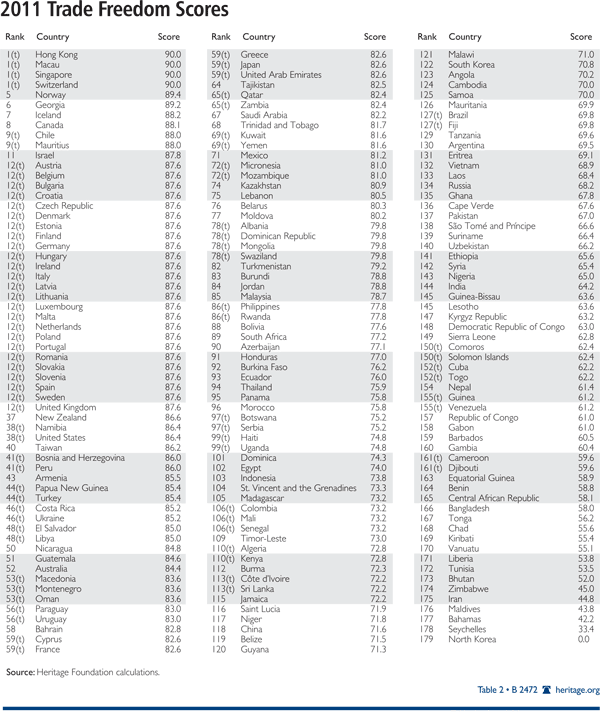Abstract: The Heritage Foundation began ranking trade freedom around the world in 1995. The newest rankings (to appear in the 2011 Index of Economic Freedom) show global trade freedom as high as it has ever been. That is encouraging: Countries with higher levels of trade freedom have higher levels of economic prosperity. Still, the latest average score showed only a slight improvement, and far too many people continue to live in poverty because their political leaders have blocked attempts at opening paths to freer trade. Countries should reduce trade barriers that protect politically powerful elites at the expense of the general population. More free trade leads to higher incomes, more jobs, and greater equality. Heritage Foundation trade policy experts Bryan Riley and Ambassador Terry Miller lay out the facts.
The 2011 rankings of trade freedom around the world, developed by The Heritage Foundation as part of its annual Index of Economic Freedom, show average trade freedom at its highest level to date.[1] Since 1995, the average score out of a possible 100 has grown from 56.7 to 74.8—an impressive 31.9 percent improvement over the 17-year period. The average score improved 0.6 point from the 2010 rankings, a significant achievement given the worldwide recession from which most countries were emerging. (See Chart 1.)

The continuing commitment to trade liberalization is good news. Countries with the highest levels of trade freedom have the most wealth, the lowest poverty rates, and the lowest levels of income inequality.
Trade Freedom Trends
More Countries Improving than Not. In the 2011 Index, 85 countries improved their scores and 58 countries declined, resulting in a “gainers to losers” ratio of 2.36 to 1. Countries whose scores changed by at least one full point demonstrated a similar trend, with 39 countries improving and 18 regressing.
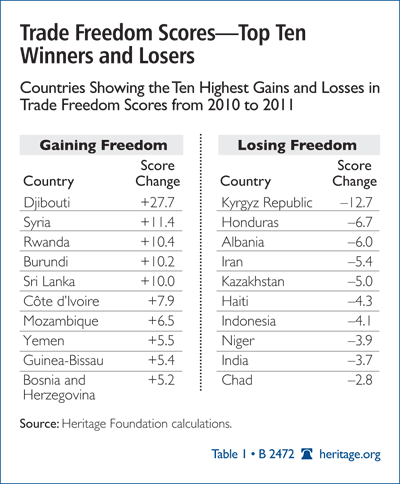
For the past 10 years, gainers outpaced losers by a ratio of 12.9 to 1. Only 11 countries had declining trade scores, and just three countries have lower trade scores now than they did in 1995: Haiti, Venezuela, and Zimbabwe.
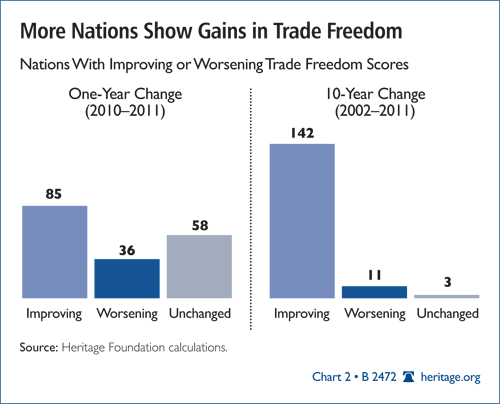
More Trade Freedom = Less Poverty. The World Bank provides poverty rates for 120 countries based on the percentage of the population who earn less than $1.25 per day.[2] The 10 countries with the highest percentage of people living in poverty have an average freedom score of only 70.3 in the 2011 Index. By contrast, the 31 countries with the lowest poverty levels have an average trade freedom score nearly 10 points higher, at 79.9. The lesson here is that reducing trade barriers reduces poverty. (See Chart 3.)
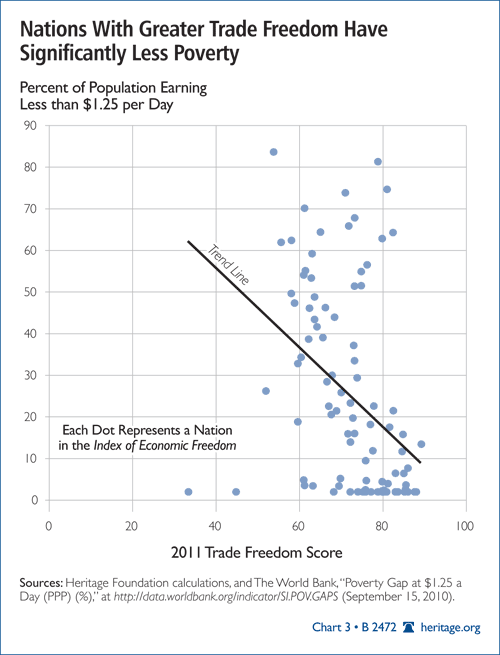
More Trade Freedom = More Equality. Many critics of international trade contend that globalization leads to a greater level of income inequality. They appear to have things backwards. The World Bank ranks 149 countries based on the percentage of national income earned by the richest 10 percent of the population. The 10 countries with the highest concentration of income in the hands of the richest 10 percent of the population have an average trade freedom score of 70.2.[3] The 10 countries with the least concentration of income in the hands of the richest 10 percent of the population have an average trade freedom score of 84.1. This comparison suggests that opponents of income inequality should advocate more trade freedom. (See Chart 4.)
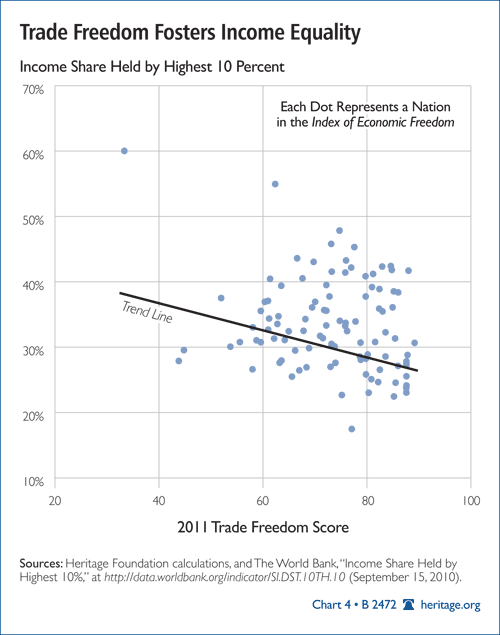
More Trade Freedom = More Money in People’s Pockets. The world’s 10 poorest countries as measured by per capita gross domestic product (GDP) have an average trade score of 64.5.[4] The 10 countries with the highest per capita GDP have an average trade score of 87.0, more than 20 points higher. These numbers support the widely accepted view among economists that free trade boosts economic growth. (See Chart 5.)
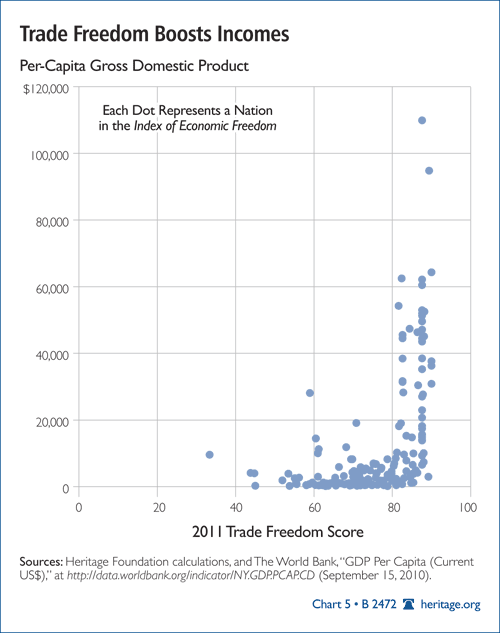
Ratcheting Down Trade Barriers
In 1947, 23 countries formed the General Agreement on Tariffs and Trade (GATT) as a forum to reduce trade barriers and to mediate disputes between trading partners.[5] Over the years, GATT members have reduced tariff and non-tariff trade barriers, and more countries have joined. In 1995, GATT became the World Trade Organization (WTO), with 128 member countries. Today there are 153 WTO members, with 31 “observer” nations interested in joining.[6]
WTO members are held to the high standards of global trade agreements, and are allowed to negotiate additional bilateral or regional free trade agreements (FTAs) and customs unions with even lower internal trade barriers than required for WTO membership. More than 200 of these regional trade agreements exist today.[7]
These institutions and agreements have helped prevent a replay of the global trade collapse that contributed to the Great Depression. In 1930, Congress passed the Smoot– Hawley Tariff Act in response to the U.S. economic crisis. Imposing new tariffs on 20,000 products ignited an international trade war as other countries retaliated by imposing tariffs on U.S.-made products, and worldwide trade declined by two-thirds.[8] These protectionist policies contributed to a decade of destroyed jobs and ruined lives.
Today, in contrast to the unconstrained protectionist free-for-all of the 1930s, the formal trade liberalization commitments and agreements embodied in organizations like the WTO help counter protectionist pressure on countries to impose new trade barriers in response to economic downturns. The continued improvement of trade-freedom scores suggests that these trade agreements help lock in lower trade barriers. Each time a new trade agreement is signed or a new country joins the WTO, the world takes another step toward free trade. Politicians in the United States and elsewhere may respond to economic pressures with pandering statements about unfair competition and assertions that these trade deals “didn’t benefit our workers,”[9] but they have been too smart, so far at least, to return to Depression-era trade policies.
Looking Ahead
Although the world’s average trade-freedom score improved since last year, the amount of improvement was modest. Far too many people continue to live in poverty because their political leaders have blocked efforts to promote economic freedom.
Whenever possible, countries should unilaterally reduce trade barriers that protect politically powerful elites at the expense of the general population. They should also continue to improve on multilateral trade agreements. Free trade will create more freedom, prosperity, and equality for everyone around the world.
—Bryan Riley is Jay Van Andel Senior Analyst in Trade Policy at the Center for International Trade and Economics (CITE) at The Heritage Foundation and Ambassador Terry Miller is Director of CITE.
Methodology
The trade-freedom scores reported in this paper are based on two inputs:
-
Trade-weighted average tariff rates, and
-
Non-tariff barriers (NTBs).
Different imports entering a country can, and often do, face different tariffs. The weighted average tariff uses weights for each tariff based on the share of imports for each good. Weighted average tariffs are a purely quantitative measure and account for the basic calculation of the score using the following equation:
Trade Freedomi = (((Tariffmax – Tariffi) / (Tariffmax – Tariffmin)) x 100) – NTBi
where Trade Freedomi represents the trade freedom in country i, Tariffmax and Tariffmin represent the upper and lower bounds for tariff rates, and Tariffi represents the weighted average tariff rate in country i. The minimum tariff is naturally zero, and the upper bound was set as a score of 50. An NTB penalty is then subtracted from the base score. The penalty of 5, 10, 15, or 20 points is assigned according to the following scale:
-
Penalty of 20: NTBs are used extensively across many goods and services and/or act to impede a significant amount of international trade;
-
Penalty of 15: NTBs are widespread across many goods and services and/or act to impede a majority of potential international trade;
-
Penalty of 10: NTBs are used to protect certain goods and services and impede some international trade;
-
Penalty of 5: NTBs are uncommon, protecting few goods and services, and/or have very limited impact on international trade; and
-
No penalty: NTBs are not used to limit international trade.
Both qualitative and quantitative information is used to determine the extent of NTBs in a country’s trade policy regime. Restrictive rules that hinder trade vary widely, and their overlapping and shifting nature makes it difficult to gauge their complexity. The categories of NTBs considered in the trade freedom penalty include:
-
Quantity restrictions: import quotas, export limitations, voluntary export restraints, import/export embargoes and bans, countertrade, etc.;
-
Price restrictions: antidumping duties, countervailing duties, border tax adjustments, variable levies/ tariff rate quotas;
-
Regulatory restrictions: licensing; domestic content and mixing requirements; sanitary and phytosanitary standards; safety and industrial standards regulations; packaging, labeling, and trademark regulations; advertising and media regulations;
-
Customs restrictions: advance deposit requirements, customs valuation procedures, customs classification procedures, customs clearance procedures; and
-
Direct government intervention: subsidies and other aids; government industrial policy and regional development measures; government-financed research and other technology policies; national taxes and social insurance; competition policies; immigration policies; government procurement policies; state trading, government monopolies, and exclusive franchises.
As an example, in 2011 France received a trade-freedom score of 82.6, based on the weighted average tariff of 1.2 percent common to all European Union countries. The tariff yields a base score of 97.6, but the existence of significant French NTBs reduces the nation’s trade-freedom score by 15 points.
Gathering data on tariffs to make a consistent cross-country comparison can be a challenging task. Unlike data on inflation, for instance, countries do not report their weighted average tariff rate or simple average tariff rate every year. To preserve consistency in grading trade policy, the authors use the most recently reported weighted average tariff rate for a country from the World Bank. If another reliable source reports more updated information on a country’s tariff rate, the authors note this fact and may review the grading if there is strong evidence that the most recently reported weighted average tariff rate is outdated.
The World Bank produces the most comprehensive and consistent information on weighted average applied tariff rates. When the weighted average applied tariff rate is not available, the authors use the country’s average applied tariff rate; and when the country’s average applied tariff rate is not available, the authors use the weighted average or the simple average of most favored nation (MFN) tariff rates.[10] In the very few cases where data on duties and customs revenues are not available, the authors use international trade tax data instead.
In all cases, the authors clarify the type of data used and the different sources for those data in the corresponding write-up for the trade policy factor. Sometimes, when none of this information is available, the authors simply analyze the overall tariff structure and estimate an effective tariff rate.
The trade-freedom scores for 2011 are based on data for the period covering the second half of 2009 through the first half of 2010. To the extent possible, the information considered was current as of June 30, 2010. Any changes in law effective after that date have no positive or negative impact.
Finally, unless otherwise noted, the authors used the following sources to determine scores for trade policy, in order of priority:
-
The World Bank, World Development Indicators 2010 and Data on Trade and Import Barriers: Trends in Average Applied Tariff Rates in Developing and Industrial Countries, 1981–2007;
-
The World Trade Organization, Trade Policy Review, 1995–2010;
-
Office of the U.S. Trade Representative, 2010 National Trade Estimate Report on Foreign Trade Barriers;
-
The World Bank, Doing Business 2010 and Doing Business 2009;
-
U.S. Department of Commerce, Country Commercial Guide, 2004–2010;
-
Economist Intelligence Unit, Country Report, Country Profile, and Country Commerce, 2004–2010; and
-
Official government publications of each country.
